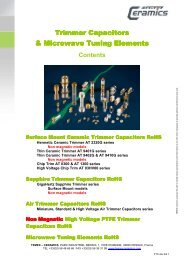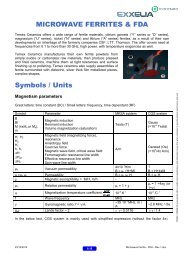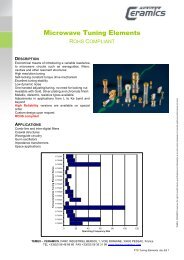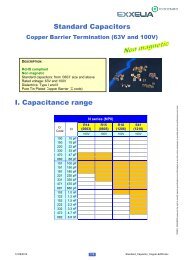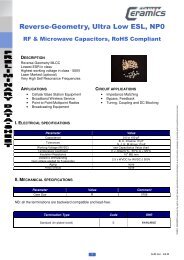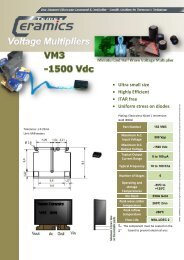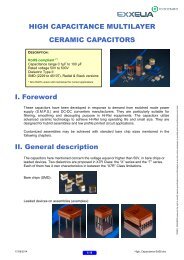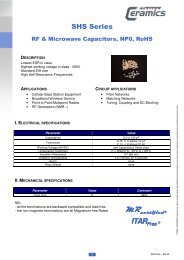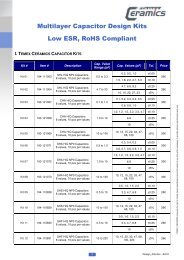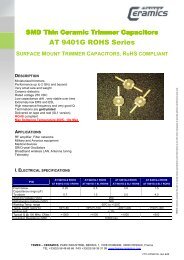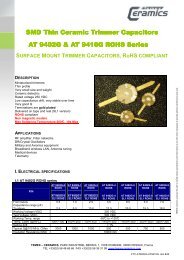Capacitor Terminations and Soldering ... - Temex Ceramics
Capacitor Terminations and Soldering ... - Temex Ceramics
Capacitor Terminations and Soldering ... - Temex Ceramics
You also want an ePaper? Increase the reach of your titles
YUMPU automatically turns print PDFs into web optimized ePapers that Google loves.
<strong>Capacitor</strong> <strong>Terminations</strong><br />
<strong>and</strong> <strong>Soldering</strong> Recommendations<br />
I. TERMINATION TYPES<br />
Our capacitors are delivered with one of the following terminations (for technical reasons, only a<br />
limited number of termination types are available in certain cases). All our terminations are backward<br />
compatible.<br />
Parameter Value Comment<br />
Termination Materials<br />
A<br />
C<br />
S<br />
non-magnetic (silver-palladium)<br />
non-magnetic (pure tin over copper barrier)<br />
lead-free (pure tin over nickel barrier)<br />
NB:<br />
- terminations type C recommended for non magnetic applications.<br />
- termination type A available for non magnetic applications (for historical reason, we have also<br />
another code, the code “P”, for the same type of termination. The parts that were designed-in before<br />
2005 might still have a code “P” instead of “A” in the part numbering. But both codes correspond to the<br />
same type of termination).<br />
II. SPECIFICATIONS<br />
Care must be taken when using particular terminations: if the terminations are heated up above a<br />
particular temperature <strong>and</strong>/or for too long a period of time, there is a risk of leaching (dissolution of the<br />
termination revealing the inner electrodes). The chart below gives the resistance to soldering heat per<br />
termination type, based on a SAC387 solder bath at 260°C.<br />
Dielectric<br />
Type<br />
A C S<br />
CHA / SHA 10 ±1s ( 3 ) 120 ±5s<br />
CHB / SHB 30 ±2s 120 ±5s<br />
CPX / CLX / CPE / CLE 30 ±2s 120 ±5s<br />
CLF 10 ±2s ( 1 ) On request 120 ±5s<br />
SHL 120 ±5s<br />
SHS 10 ±1s ( 4 ) 120 ±5s<br />
SHF / SHN / SHT 5 ±1s ( 2 ) 120 ±5s<br />
( 1 ): results extrapolated from 30±2s data obtained with Sn62/Pb36/Ag2 solder bath.<br />
( 2 ): data obtained with Sn62/Pb36/Ag2 solder bath.<br />
( 3 ): termination only available on CHA series.<br />
( 4 ): preliminary data.<br />
TEMEX CERAMICS reserves the right to modify herein specifications <strong>and</strong> information at any time when necessary to provide optimum performance <strong>and</strong> cost.<br />
1<br />
Attachment_Techniques - Ed.33
<strong>Capacitor</strong> <strong>Terminations</strong><br />
<strong>and</strong> <strong>Soldering</strong> Recommendations<br />
III. STANDARD SMD REQUIREMENTS<br />
III.1. <strong>Soldering</strong> Recommendations<br />
Regarding the soldering attachments, three methods are generally used: the vapor phase soldering,<br />
the infrared reflow soldering <strong>and</strong> the wave soldering. Unless particular skill about the use of the wave<br />
soldering, this method is not recommended since the melted solder is directly in contact with the<br />
ceramic. This can potentially crack the capacitor because the ceramic is sensible to the thermal<br />
shocks. Moreover, this method needs to maintain the components with an insulating resin which<br />
increases the thermo-mechanical strains between the ceramic <strong>and</strong> the board both on soldering phase<br />
<strong>and</strong> operating condition. The vapour phase <strong>and</strong> IR reflow soldering are less aggressive, inducing more<br />
restricted thermal shocks. This is the reason why they are preferred to the wave soldering method for<br />
reliable applications. In all cases, proper pre-heating is essential.<br />
The circuit should be pre-heated at a typical rate of 1°C/s within 65°C to 100°C of the maximum<br />
soldering temperature. While multilayer ceramic capacitors can withst<strong>and</strong> the peak soldering<br />
temperatures for short durations, they should be minimized whenever possible.<br />
Above precaution given for SMD types are applicable for the implementation of large bare chips (1515<br />
<strong>and</strong> above). But in general, large bare chips above 2225 are not recommended to be mounted on<br />
epoxy printed board due to the thermal expansion mismatch between ceramic capacitor body <strong>and</strong><br />
epoxy. This is the reason why leaded components will be preferred especially for reliable applications.<br />
For information, the typical thermal profiles of these three soldering processes are given hereafter.<br />
These typical diagrams are only given as an aid to SMD users in determining specific processes<br />
linked to their instrumentations <strong>and</strong> to their own experience.<br />
NB: reference documents are IEC 61760-1, CECC30000 <strong>and</strong> IEC68 st<strong>and</strong>ards. Please, refer to this<br />
st<strong>and</strong>ard for more information.<br />
TEMEX CERAMICS reserves the right to modify herein specifications <strong>and</strong> information at any time when necessary to provide optimum performance <strong>and</strong> cost.<br />
2<br />
Attachment_Techniques - Ed.33
<strong>Capacitor</strong> <strong>Terminations</strong><br />
<strong>and</strong> <strong>Soldering</strong> Recommendations<br />
III.1.1. Vapour Phase <strong>Soldering</strong><br />
Lead free SnAgCu solders - Vapour Phase<br />
SnPb solders - Vapour Phase<br />
NB: the lines indicate the upper <strong>and</strong> lower limits of typical process (terminal temperature).<br />
III.1.2. Infrared <strong>Soldering</strong><br />
Lead free SnAgCu solders – Infrared <strong>Soldering</strong><br />
SnPb solders – Infrared <strong>Soldering</strong><br />
NB:<br />
- these profiles are given for mid size components.<br />
- continuous lines: typical process (terminal temperature).<br />
- dotted lines: process limits, bottom process limit (terminal temperature), upper process limit (top<br />
surface temperature).<br />
TEMEX CERAMICS reserves the right to modify herein specifications <strong>and</strong> information at any time when necessary to provide optimum performance <strong>and</strong> cost.<br />
3<br />
Attachment_Techniques - Ed.33
<strong>Capacitor</strong> <strong>Terminations</strong><br />
<strong>and</strong> <strong>Soldering</strong> Recommendations<br />
III.1.3. Wave <strong>Soldering</strong><br />
NB:<br />
- continuous lines: typical process.<br />
- dotted lines: process limits.<br />
III.2. Moisture Sensitivity Classification<br />
SnAgCu <strong>and</strong> SnPb solders - Double Wave <strong>Soldering</strong><br />
Our st<strong>and</strong>ard lead-free terminations - S <strong>and</strong> C types - have been fully tested <strong>and</strong> are compliant with<br />
the requirements mentioned in specification JEDEC STD 020 (level 1: not moisture sensitive).<br />
III.3. Whiskers Classification<br />
Our st<strong>and</strong>ard lead-free terminations - S <strong>and</strong> C types - have been fully tested <strong>and</strong> are compliant with<br />
the requirements mentioned in specification JEDEC STD 201. Our terminations exhibit a matte finish<br />
<strong>and</strong> receive a special heat treatment to relieve stress inside the tin.<br />
TEMEX CERAMICS reserves the right to modify herein specifications <strong>and</strong> information at any time when necessary to provide optimum performance <strong>and</strong> cost.<br />
4<br />
Attachment_Techniques - Ed.33
<strong>Capacitor</strong> <strong>Terminations</strong><br />
<strong>and</strong> <strong>Soldering</strong> Recommendations<br />
III.4. Pad Dimensions<br />
The metallized pads on the end user's substrate must be properly designed. Improper spacing or<br />
dimensioning of the pads may result in poor solder joints or a tombstone effect. Pad designs are given<br />
below for the most common sizes of multilayer ceramic capacitors for both wave <strong>and</strong> reflow soldering.<br />
X<br />
X<br />
W<br />
D<br />
Case Size W X D L<br />
SHL<br />
(0402)<br />
CHA / SHA<br />
(0505)<br />
SHS<br />
(0603)<br />
SHF<br />
(0805)<br />
CHB / SHB<br />
(1111)<br />
CPX / CLX<br />
(2225)<br />
CPE / CLE<br />
(4040)<br />
L<br />
0.70mm 0.90mm 0.40mm 2.20mm<br />
1.80mm 1.00mm 0.80mm 2.80mm<br />
1.00mm 1.10mm 0.60mm 2.80mm<br />
1.50mm 1.30mm 0.60mm 3.20mm<br />
3.00mm 1.00mm 1.90mm 3.90mm<br />
6.90mm 1.00mm 5.00mm 7.00mm<br />
10.20mm 1.00mm 8.30mm 10.30mm<br />
NB: these dimensions are suggested for a reflow soldering process. If a wave soldering process is<br />
used, the X dimension has to be increased by 0.50mm (0.40mm for L <strong>and</strong> A case sizes), thus leading<br />
to an increase of 1.00mm to the L dimension (0.80mm for L <strong>and</strong> A case sizes).<br />
TEMEX CERAMICS reserves the right to modify herein specifications <strong>and</strong> information at any time when necessary to provide optimum performance <strong>and</strong> cost.<br />
5<br />
Attachment_Techniques - Ed.33
<strong>Capacitor</strong> <strong>Terminations</strong><br />
<strong>and</strong> <strong>Soldering</strong> Recommendations<br />
IV. SPECIFIC REQUIREMENTS<br />
IV.1. Large Sizes<br />
<strong>Capacitor</strong>s with dimensions greater than or equal to 1515 size code (i.e. greater than or equal to<br />
3.81mm x 3.81mm) are not usually h<strong>and</strong>led by pick <strong>and</strong> place equipments. Therefore, manual<br />
soldering has to be used <strong>and</strong> the capacitors undergo a pre-heating sequence prior to the soldering<br />
operation. The steps are required to avoid damage which may affect the reliability of the capacitors :<br />
- three heating plates must be used as follows :<br />
→ heating plate at 120°C for 5 to 10 minutes;<br />
→ heating plate at 170°C for 5 to 10 minutes;<br />
→ heating plate at 240°C for 5 to 10 minutes.<br />
When using chips with ribbons, the capacitor <strong>and</strong> its ribbon must be pre-heated on a heating plate<br />
prior to any soldering operation. Do not heat the ribbons above 280°C for more than 10s.<br />
Mounting chips larger than 2225 size directly onto epoxy printed boards is not recommended due to<br />
the thermal expansion coefficient mismatch between the ceramic capacitor body <strong>and</strong> the epoxy. In<br />
such cases, chips equipped with wires <strong>and</strong> ribbons are preferable.<br />
IV.2. Silver-Palladium <strong>Terminations</strong><br />
The silver-palladium non-magnetic termination – A type - has a lower wettability than the st<strong>and</strong>ard<br />
terminations - S or C types. Actually, this is a typical phenomenon as these non-magnetic terminations<br />
do not have a tin layer. These kind of terminations are not compatible with SAC soldering. To improve<br />
the wettability of such terminations, we recommend the following:<br />
- use a more activated flux;<br />
- increase the quantity of soldering paste;<br />
- use an nitrogen controlled atmosphere if appropriate.<br />
If the customer's production process cannot be modified as suggested above, the use of a C-type<br />
termination (copper barrier with tin layer) will solve the problem.<br />
TEMEX CERAMICS reserves the right to modify herein specifications <strong>and</strong> information at any time when necessary to provide optimum performance <strong>and</strong> cost.<br />
6<br />
Attachment_Techniques - Ed.33
<strong>Capacitor</strong> <strong>Terminations</strong><br />
<strong>and</strong> <strong>Soldering</strong> Recommendations<br />
IV.3. H<strong>and</strong> <strong>Soldering</strong><br />
The most important aspect of h<strong>and</strong> soldering is operator skill. Care should be taken to avoid touching<br />
the capacitor with bare h<strong>and</strong>s <strong>and</strong> to prevent the tip of the soldering iron coming into contact with the<br />
ceramic component. If h<strong>and</strong> soldering is the choosen technique, the following rules must be observed:<br />
- pre-heat the circuit to 150°C;<br />
- do not put the ceramic <strong>and</strong>/or termination in contact with the iron tip;<br />
- maximum tip temperature of 315°C;<br />
- maximum tip diameter of 3mm;<br />
- soldering time must be very quick (a couple of seconds).<br />
NB: multilayer ceramic capacitor attachments with a soldering iron are discouraged due to the process<br />
control limitations.<br />
IV.4. Flux<br />
Flux applied to surfaces that are to be joined by soldering. The flux cleans the surfaces, prevents<br />
oxidation during soldering <strong>and</strong> results in a better bond. The flux must be compatible with the soldering<br />
temperature <strong>and</strong> soldering times given in this document.<br />
IV.5. Storage Conditions<br />
It is recommended to store the capacitors at ambient temperature of 5 to 40°C <strong>and</strong> 20 to 70%RH<br />
humidity. The parts should be used within 6 months from the time of delivery. If the parts are stored<br />
over six months, a solderability test has to be performed prior use in production.<br />
When the chip monolithic ceramic capacitors are stored in high temperature <strong>and</strong> humidity conditions<br />
or corrosive environments - such as with sulfide or chloride gas, acid, alkali or salt - the surface of<br />
terminations (external electrode) deteriorates causing solderability to degrade. Such a solderability<br />
degradation could also occur if the parts are stored out of their packaging (reel or plastic bag) for a<br />
long period of time. In this case, the terminations must be checked (to avoid oxidation for instance)<br />
<strong>and</strong> a solderability test must be performed.<br />
Generally speaking, no surface preparation is required. However, it may be advantageous to clean the<br />
HiQ capacitors with any st<strong>and</strong>ard microelectronic cleaning solvent to remove dust <strong>and</strong> other agents.<br />
TEMEX CERAMICS reserves the right to modify herein specifications <strong>and</strong> information at any time when necessary to provide optimum performance <strong>and</strong> cost.<br />
7<br />
Attachment_Techniques - Ed.33
<strong>Capacitor</strong> <strong>Terminations</strong><br />
<strong>and</strong> <strong>Soldering</strong> Recommendations<br />
V. LEADS AND WIRES<br />
V.1. Leads <strong>and</strong> Wires Types<br />
Termination Type Code Description<br />
1 Micro-strip Ribbon<br />
1S<br />
Short Micro-strip Ribbon<br />
2 Axial Ribbon<br />
3 Radial Ribbon<br />
4 Narrow Axial Ribbon<br />
5 Narrow Micro-strip Ribbon<br />
6 Radial Wire<br />
7 Axial Wire<br />
TEMEX CERAMICS reserves the right to modify herein specifications <strong>and</strong> information at any time when necessary to provide optimum performance <strong>and</strong> cost.<br />
8<br />
Attachment_Techniques - Ed.33
<strong>Capacitor</strong> <strong>Terminations</strong><br />
<strong>and</strong> <strong>Soldering</strong> Recommendations<br />
V.2. Leads <strong>and</strong> Wires Matrix<br />
Termination Type Code CHB SHB CLX / CPX CLE / CPE CLF<br />
Micro-strip Ribbon 1 AVAILABLE AVAILABLE AVAILABLE AVAILABLE AVAILABLE<br />
Short Micro-strip Ribbon 1S AVAILABLE<br />
Axial Ribbon 2 AVAILABLE AVAILABLE<br />
Radial Ribbon 3 AVAILABLE<br />
Narrow Axial Ribbon 4<br />
Narrow Micro-strip Ribbon 5 AVAILABLE<br />
Radial Wire 6 AVAILABLE AVAILABLE AVAILABLE AVAILABLE<br />
Axial Wire 7 AVAILABLE AVAILABLE AVAILABLE<br />
V.3. Leads <strong>and</strong> Wires <strong>Soldering</strong> Conditions<br />
Leads <strong>and</strong> wires are soldered to the chip capacitor using HMP soldering paste at 300°C. Therefore,<br />
these assemblies are suitable for a generic SMD soldering profile – with lead or lead-free soldering<br />
paste – or h<strong>and</strong> soldering as long as operating conditions <strong>and</strong> recommendations described in this<br />
document are fulfilled.<br />
TEMEX CERAMICS reserves the right to modify herein specifications <strong>and</strong> information at any time when necessary to provide optimum performance <strong>and</strong> cost.<br />
9<br />
Attachment_Techniques - Ed.33
<strong>Capacitor</strong> <strong>Terminations</strong><br />
<strong>and</strong> <strong>Soldering</strong> Recommendations<br />
V.4. Leads <strong>and</strong> Wires Dimensions<br />
Within each cell, the length is given first, then the width/diameter of any single ribbon or wire.<br />
Termination Type Code CHB SHB CLX / CPX CLE / CPE CLF<br />
Micro-strip Ribbon 1<br />
8.00<br />
2.40<br />
8.00<br />
2.40<br />
8.00<br />
5.40<br />
16.00<br />
8.90<br />
6.10<br />
15.00<br />
Short Micro-strip Ribbon<br />
1S<br />
8.50<br />
8.90<br />
Axial Ribbon 2<br />
8.00<br />
2.40<br />
16.00<br />
8.90<br />
Radial Ribbon 3<br />
Narrow Axial Ribbon 4<br />
Narrow Micro-strip Ribbon 5<br />
Radial Wire 6<br />
Axial Wire 7<br />
8.00<br />
2.40<br />
8.00<br />
1.27<br />
20.00<br />
0.60<br />
20.00<br />
0.60<br />
NB: dimensions are in mm, length is the minimum value.<br />
V.5. Interaxial Dimensions<br />
30.00<br />
0.60<br />
30.00<br />
0.60<br />
30.00<br />
0.90<br />
30.00<br />
0.90<br />
Termination Type Code CHB CLX / CPX CLE / CPE CLF<br />
30.00<br />
0.90<br />
Radial Wire 6 7.62±0.80 12.70±0.80 15.24±0.80<br />
NB: dimensions are in mm.<br />
TEMEX CERAMICS reserves the right to modify herein specifications <strong>and</strong> information at any time when necessary to provide optimum performance <strong>and</strong> cost.<br />
10<br />
Attachment_Techniques - Ed.33




